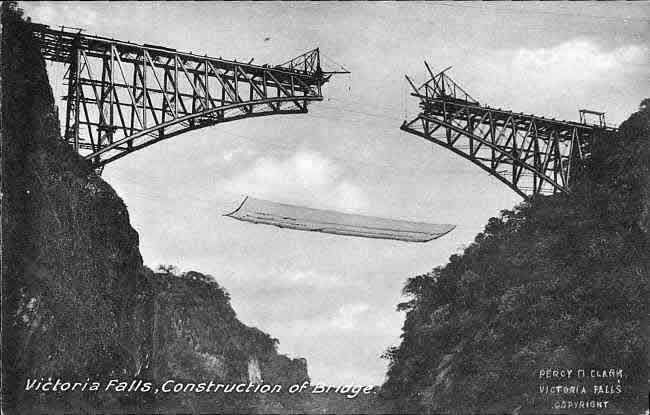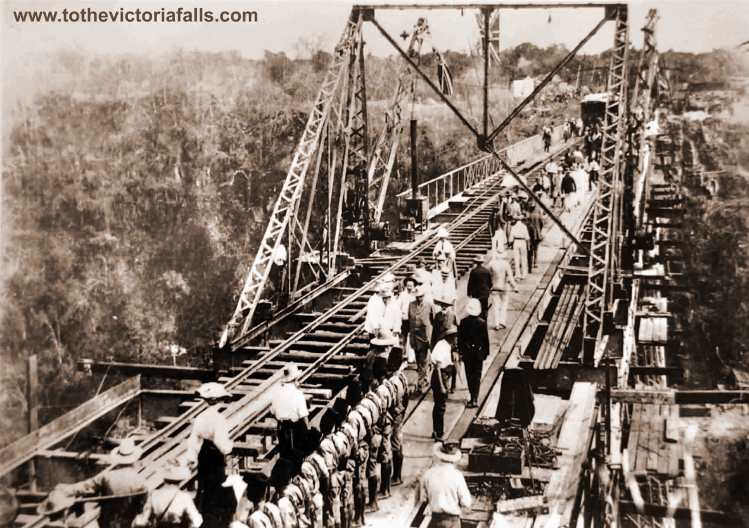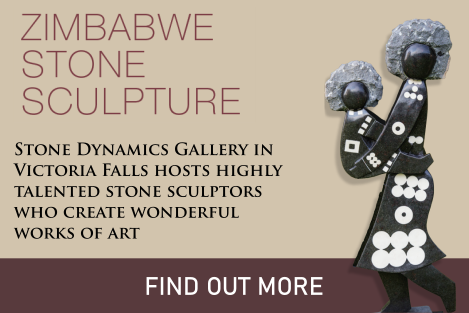Victoria Falls Bridge Construction
The main credit for designing the Victoria Falls Bridge must go to George Andrew Hobson of London based consultants Sir Douglas Fox and Partners (later to become Freeman, Fox and Partners), not as is often stated, Sir Ralph Freeman, the engineer who would later design of the famous Sydney Harbour Bridge in 1932 (and also the Birchenough Bridge across the Save River in 1935). At the time of the design of the Victoria Falls Bridge, Freeman was still only an assistant in the firm. Several leading firms tendered for the construction of the bridge but most were daunted by the task and in the end, only two firms, Dorman, Long & Co. and the Cleveland Bridge & Engineering Company of Darlington, were in the running. In May 1903 both parts of the contract were awarded to The Cleveland Bridge Company, to construct and erect the Victoria Falls Bridge for a price of £72,000. The bridge was made, and assembled in sections to ensure accuracy, at the steel works in Darlington, England, and shipped in knocked down pieces to Beira on the S.S. Cromwell and then put on the Beira and Mashonaland Railway to Bulawayo, and on to the Victoria Falls on the new rail-line. In late 1903 Georges C Imbault, a young gifted French engineer working with The Cleveland Bridge Company, had been appointed Chief Construction Engineer on site. Together with Mr Stephen F Townsend, Resident Engineer for Rhodesia Railways (based in Bulawayo) and Mr Charles Beresford Fox, nephew of Sir Douglas Fox, representing the bridge designers, they visited the site to survey for the proposed bridge, and with Sir Charles Metcalfe they decided, on 2 September 1903, the final location of the bridge, over the second gorge close to the boiling pot. The choice of the site was finally governed by the natural formation of the rock walls of the gorge, advantage being taken of the minimum distance to be spanned, combined with the soundest foundations obtainable. The first work after the completion of the railway up to the site was, of course, the building of the concrete foundations, the excavations for which had been previously prepared by the permanent staff of the railway-company. Work having started in May, the concrete foundations for the bridge were finally ready in October 1904. At the same time the anchorages for sustaining the main span during its cantilever stage were prepared, and the building of the main bridge structure commenced on 21 October. The two side spans of the bridge, supported on the abutments and anchored to the rock behind by steel cables, were completed in late December 1904.
Once underway the building of the main arch progressed rapidly. The arch was erected simultaneously from either side as two cantilevers, with the two arms anchored on either side by twelve high tension steel wire hawsers running through galleries cut into the rock. As the work was proceeding from the two sides of the gorge, daily observations were taken to see that the centre line of the bridge was maintained. A team of about 30 skilled European engineers erected the steelwork, assisted by hundreds of local African labourers, being paid from 10 shillings to £3 per month. As many as 400 had been employed at one period, although the average number during construction was about 200. The building of the bridge progressed smoothly and on 1 April 1905 the main arch was linked. The closing was a triumphant event and took place without a hitch. So precise were the calculations that Imbault had allowed for the fact of spray on the girders which would have slowed heat absorption and, therefore, expansion of the metal. There was great consternation just a few minutes after dawn that day when it was seen that, unpredictably, the wind had shifted and the bridge had remained dry. Fortunately, concern was unwarranted for the two great steel semi-arches were perfectly joined; the rivet holes of the cover plates and those of the boom coincided and were instantly bolted. The engineering company, Sir Douglas Fox and Partners, announced to the world that the great bridge over the gorge at the Victoria Falls, was linked up at 6 o'clock on Saturday morning, in the presence of Sir Charles Metcalfe.
The bridge with temporary railway track
Return from the Victoria Falls Bridge Construction to our Victoria Falls home page |
|
||||
|
|
|||||
|
|
|||||
|
| |||||





